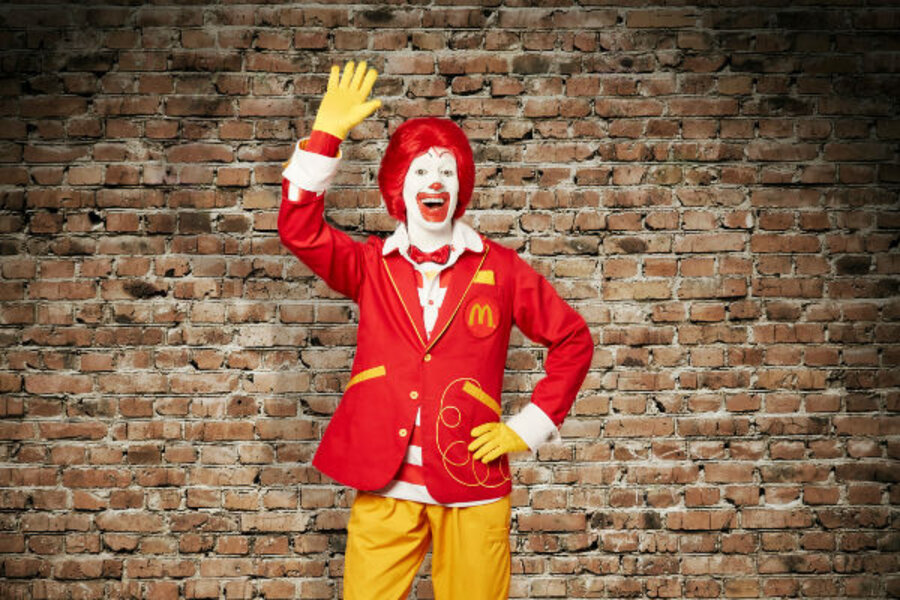Ronald McDonald: Does the clown still capture fans?
Loading...
Ronald McDonald, spokesperson, fast foodie, and clown-about-town may have gotten a new stylist and an added social media presence, but that doesn’t solve the issues parents have with nutritional value of fast foods or many kids’ fear of clowns.
From the response on Twitter to the new #ronaldmcdonald hashtag, it seems as if many are asking why we are clowning around updating fast-food mascots at all.
Perhaps it’s just easier to try and win us over with style over more substantial improvements.
Whatever the reason, Ronald McDonald has made the switch from balloonish yellow jumpsuit to a sport coat, red and white inmate stripe shirt, and yellow slacks.
According to People Magazine, “The move marks a turnaround from recent years, when the red-haired mascot faded to the background as McDonald's came under criticism for using him to market to children.”
It wasn’t all that long ago that I wrote about Hannah Robertson, 9, the little girl whose mom is an activist for parents and kids working together to make healthier food choices.
The little girl who stood up to McDonald’s CEO Don Thompson and asked him during a board meeting to offer more healthy choices to kids.
At that point, Thompson told the girl a whopper, by saying that his fast-food chain doesn’t sell “junk food.”
McDonald’s has been hounded on a daily basis by parents and advocacy groups like Corporate Accountability International, based in Boston, demanding that the corporate giant back off their continued practices of marketing to children.
"This is yet another symptom of McDonald's brand-image crisis. While the industry is increasingly trending towards the call of thousands of health professionals and moms to stop marketing junk food to kids, McDonald's is desperately doubling down on its oldest kid-targeted marketing tactic--a creepy old clown,” writes Jesse Bragg, press secretary of CAI, in an email.
“You can put cargo pants on a clown that markets junk to kids but its still just a clown that markets junk to kids."
Meanwhile, my 10-year-old looked at the computer screen this morning like he was seeing into the jaws of the final boss on Epic Battle Final Fantasy Four as he took in the new Ronald McDonald look.
“He’s scarier than he was before,” said my son Quin. “You never see any human parts showing on a clown. No real skin or hair, everything just hidden and fake.”
Quin’s description made me wonder if the very reasons why clowns scare kids are the same qualities that might attract businesses selling fast-food to kids – no humanity is visible, and you can wear any face you paint on.
Apparently, the marketing people for the Golden Arches don’t suffer from the fairly common fear of clowns, which is present in children and (thanks to numerous horror movies with the clown as the bad guy), adults too.
There’s just something about whitewashed faces, faces that smile without actual joy being present, noses that honk, larger-than-life personas, and the primary colored features of clowns that seems to creep people out.
In a 2013 report about clowns – NPR reporter Audie Cornish says that while she's not afraid of clowns, "The bigger thing, though, is that I just don't find them funny."
Ms. Cornish stresses, “it's important to remember that clowns were considered adult entertainment when they first appeared.”
While clowns are often considered “fun for all ages, yet plenty of people are downright scared of them. There's even a word for it: coulrophobia, though that's not an official diagnosis,” according to NPR.
“Clowns scare me because clowns are a lie,” Quin explained. “Their faces smile even when they’re not happy.”
Perhaps McDonalds is just testing the waters to see if it’s safe for Ronald to come out of the shadows without drawing fire from activists.
Because, if this really is “a turn-around move” for McDonald’s, they are going to need a lot more spin to win kids and parents over than just a hashtag, a new outfit, and a painted on grin.








